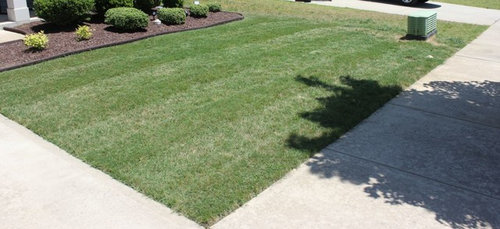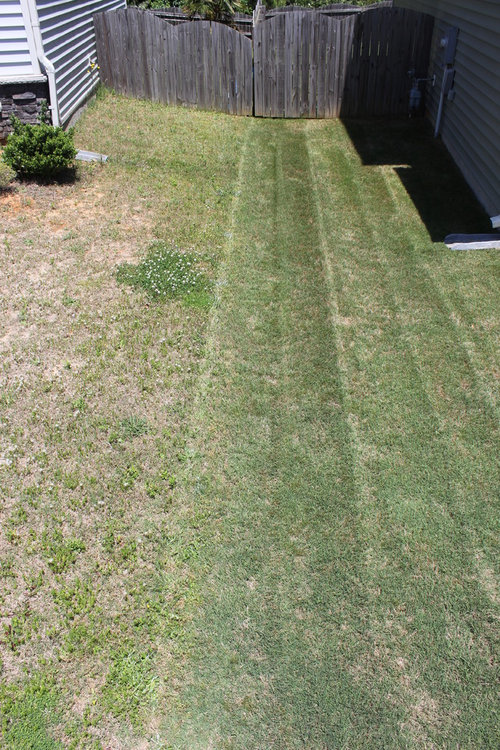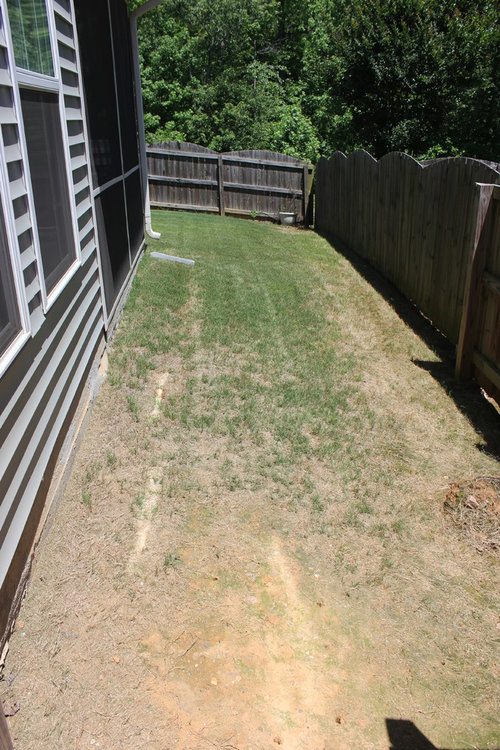Soil test results - A man needing a plan
Where my lawn has been:
My lawn is 5 years old. Bermuda Tifway 419 sod laid by the builder when my home was built. Yard is approximately 3,000 square feet front and back. I live in Fuquay Varina, NC which is about a half hour south of Raleigh.
For the first few years I only watered sporadically when I felt it was needed (Read as new homeowner with no clue what he was doing). Initially I purchased a reel mower with the intent on using it exclusively. We received a regular gas powered mower as a gift a short time later and I never went back to the reel mower due to the convenience of the powered mower. I kept the height low and mowed regularly. I may give the reel mower a shot again at some point.
Weed control has been the standard big box store variety including Ortho weed be gone and Bayer Advanced along with as much hand pulling of weeds as I can take. Last year after noticing some areas starting to thin I decided I needed to be more proactive with my lawn care. I started early spring with Scotts Halts pre-emergent and then Ortho Weed spray as needed throughout the year for weed control. Scotts GreenMax fertilizer was used twice during the summer and Scotts Turfbuilder Winterguard once in the late fall.
Where my lawn is now:
My lawn was pretty good last year, I definitely saw an improvement with the fertilizer applications. We had an inconsistent transition from winter to spring this year. The previous year I put down pre-emergent in early March. This year the temps stayed colder longer and kept switching from warm ups to cold fronts through April. As a result, I didn't put down any pre-emergent since I couldn't time the weather transition. I also made the mistake of using Scott's Weed and Feed in mid April. So I believe this not only hindered the Bermuda emerging from winter hibernation, it also fed the weeds which exploded in late April due to the amount of rain we received. Lesson learned.
Where I'd like my lawn to go:
Up to this point I've pretty much been winging it trying to figure out a lawn care plan on my own. I decided to search the internet for some assistance and luckily found a few online forums like this one with great people willing to share their knowledge and experience. After gaining some insight on this forum, I recently shampoo'd my lawn (did I just say that?) and got a soil sample test (Results below). I also purchased a bottle of Celsius WG, but haven't used it yet (Would I have rather spent a 100 bucks on a bottle of Scotch, absolutely yes now, ask me again later).
My lawn is pretty good, especially compared to others in my neighborhood, but I know it can be better. I want the lawn care pro's to drive by and wonder what company is taking such good care of my lawn. :) I would like to thicken and strengthen my lawn so that it can live up to its full potential. I don't mind putting in the effort required, I just need some assistance with developing a yearly lawn care plan. I am very interested in going the organic route, but I"m not sure where to start and have a lot more research to do. Any suggestions or insight are welcome and appreciated, thanks!
- Chad
Photos and Test results:
Front Yard

Close up of thinning area around cable box. The box is on the middle of the property line. Half of the box and down is my lawn,

Front Left side of house. My lawn is the right half, neighbors on the left. As you can see my neighbor has pretty much given up on his lawn as there is basically no Bermuda left on his side, only weeds and bare spots.

Front right side of house

Close up of thinning around the fence gate and the A/C drain pipe. Excess condensation drains from the pvc pipe and is causing a large bare spot. I may dig a small hole where the pipe drains and fill with drainage rock to see if that helps but need to do more research.

This is the worst spot, just on the other side of the gate. This area gets a lot of shade as it is surrounded on 3 sides (house, gate, side fence) and the Bermuda clearly doesn't like it and wants more sun. Not sure there is much I can do here other than plant a garden. :)

Backyard. Have some thinning next to the house due to the shade from the house. Will most likely be adding a small patio in that area at some point in the future so I'm not too worried about that area. The left half of this photo usually has the most dense part of the lawn due to it receiving the most sun.

Here come the weeds... a closer up shot of a rough spot in the backyard. The grass at the very top of the photo is dense and fairly weed free, and the yellowed spots are what is left of a large weed patch after a spray of Weed B Gone. It is amazing how nice and uniformly green a lawn looks from a distance and then the closer you look the more weeds you spot.

Logan Labs test results

Комментарии: 9
Super-Sod
Год(а)/Лет назад: 8First of all, nice mow strips in the front yard!
Regarding the shady areas and TifWay 419, you are on the right track with letting the lawn tell you that it doesn't get enough sun and to convert those areas into a patio or garden. They would be good places to turn into a cozy hang-out area or to create more shade . . . plant small trees such as a crapemyrtle, dogwood, grancy graybeard, cherry, serviceberry or the like. I love pine straw mulch to cover over problem areas until I can fix them properly - it's a pretty place holder!
You mention wanting to go the organic route and for the weeds the best way is old fashioned had weeding - that's what I do and it's relaxing and effective and good arm exercise. It also goes quicker than you might think. It's past time for a pre-emergent to work (the tiny little seedlings have already germinated, even if you can't see them, the are likely there) and post-emergent is your only other solution, but make sure you get a selective kind that won't kill the Bermuda. Also, another organic option for the time-being is to keep the lawn/weeds mowed so that more weed seeds don't form and increase the problem next year (i.e., don't let weed growth get away from you - if you go on summer vacation, make sure you have somebody mow it for you!).
It's easier to go the organic route regarding fertilization: we recommend COMPOST topdressing and aerating with a core aerator. In fact, I highly recommend that from the looks of your lawn which is looking good, but you want it to look GREAT. The compost will add nutrients and good bacteria into the soil and increase water holding capacity. The core aeration (a core aerator pulls out little plugs rather than just piercing/slicking the soil like a knife . . . core aeration is more effective) will alleviate compaction, improve aeration, and help the compost get down into the root zone. This compost/aeration practice increases vigor in lawns. We recommend it as a yearly organic practice.
Best Wishes,
HillaryUser
Год(а)/Лет назад: 8I'll let you research our opinion of core aeration. Hint: I'm not a fan. And skip the compost, it's expensive, difficult to apply, a lousy feeding, and unnecessary to add bacteria, which float around on the wind for free.
You can technically apply pre-emergent at any point as weeds will sprout continuously on well-irrigated lawns. However, it's best to get the shield up early to catch that first huge flush of spring-sprouting weeds.
Overall, quality of even this well-cared-for lawn is fair at best. Fortunately, the soil test tells us exactly why this is and how to fix it, so let's explore further...
EC 4.1: A very sandy soil. Your soil's going to shift quickly due to the low carrying capacity for resources, so plan on testing it yearly.
OM 3.7%: Actually, this is well into the Fair range, but I'd like to get this up a lot higher due to your low EC as organic matter raises EC. Organic feedings, mulch mowing, mowing in all fall leaves, and so on will help here. It's not an emergency, just something to work on.
Sulfur 77: Rather high, with little margin to play with. Fortunately, I don't need to do much playing and your sulfur levels are certainly not a problem.
Phosphorus 9: So low it practically doesn't exist in your soil, which is seriously killing your lawn quality (and explains your neighbors' problems quite nicely). I've made recommendations below, but we're not going to finish this year. Target will be 200. Purchase the cheapest starter fertilizer as they'll all target about 1 pound per thousand square feet of phosphorus. Nitrogen levels are high enough to maintain your lawn beautifully.
Calcium 46.0%: Very low, and a serious limiter of your lawn quality (again, this explains the neighbors'). Recommendations below. Purchase Encap or Mag-I-Cal lime as other limes aren't as strong, won't work as fast, and contain other elements that I don't want to be adding to your soil.
Magnesium 9.1%: A little low, but nothing severe. Buy a nice large bag of Epsom salt at your local drugstore, in the bath or first aid section. Recommendations below.
Potassium 6.5%: Exactly where it should be by the numbers, the percentage is a little over-inflated due to the lack of sufficient calcium in your soil. This will settle down after the calcium application.
Minor Elements: Although I'd like to shift boron, copper, and zinc, there's so much going on this year that I'm going to skip it as I risk not having it stick very well. I mentioned iron below.
Iron 49: Not deficient in the slightest, but not high enough to produce great color on the lawn. Any time you like, you can apply Milorganite to raise your iron levels (slowly) and add a little organic material to the soil.
Recommendations:
June 1: Feed at bag rate with starter fertilizer.
June 15: Apply 4 pounds per thousand square feet Encap or Mag-I-Cal calcitic lime.
July 1: Feed at bag rate with starter fertilizer.
July 15: Apply 1 pound per thousand square feet Epsom salt.
August 1: Feed at bag rate with starter fertilizer.
September 1: Feed at bag rate with starter fertilizer.
September 15: Apply 3 pounds per thousand square feet Encap or Mag-I-Cal calcitic lime.
October 1: Feed at bag rate with starter fertilizer.
October 15: Apply 1 pound per thousand square feet Epsom salt.
daedlus4
АвторГод(а)/Лет назад: 8Thanks Hillary and Morph, appreciate you both taking the time to read my post and offer suggestions. I have read several articles and posts on the eternal battle of the pros/cons of core aeration. I am intrigued by the liquid method of softening soil and I'd like to see how the shampoo method plays out.. The time/money/effort is significantly less and worth the try first in my opinion.
Morph, I really appreciate the detailed breakdown of the soil sample test. Not only for myself, but for the "who knows how many" you have done for others on this forum. If Logan charges $25 for the soil test, your breakdown of the results and recommended actions are worth at least as much. Shoot me an e-mail to i411sub at yahoo dot com and let me know where I can mail a check or a case of beer to. I am excited to now have a plan and am looking forward to learning more about my soil and lawn so that I can better anticipate its needs in the future. Thank you!- Chad
daedlus4
АвторГод(а)/Лет назад: 8Well in that case I am going to drink the beer, and I'll keep the cash handy in case I am ever in PA and happen to run into you. Appreciate it!
- Chaddanielj_2009
Год(а)/Лет назад: 8Последние изменения: Год(а)/Лет назад: 8I like the way Chad thinks: Hey buddy, I just picked up a case of beer for ya. Where do I send it? Don't want it ya say? OK, then guess I'll have to drink it instead...ya know, just so it doesn't go to waste. :)
Also, be sure to follow dchall's recommendations on watering routine and grass height. If you do what these guys say you'll have the best (edited to say by "best" I mean "healthiest") lawn in the county.
daedlus4
АвторГод(а)/Лет назад: 8I am all about recycling! I will be sure to check out dchall's watering routine. There is a wealth of knowledge on this forum. I hope I can absorb even a small portion of it. Thank you.
- Chaddchall_san_antonio
Год(а)/Лет назад: 8If Hillary had posted her comments in 1990, everyone would have agreed. Nowadays we have moved on from the "compost is king" approach started by Rodale in the 1930s. Compost is expensive, cumbersome, time consuming, and you stand a decent chance of over using it and smothering the lawn. The grain type materials used in today's organic fertilizers provide much more benefit to the soil for about 1/20 the cost and time wasted by compost. Most of us are using grains found at our local feed store. Use whatever is inexpensive or fits your budget. I like corn meal and alfalfa pellets. Morph likes soybean meal and Milorganite (not a grain, but better than compost). The application rate for the grains is 15-20 pounds per 1,000 square feet, but if you make a mistake it won't do any harm. Grains work by feeding real food to the microbes living in your soil. In turn they consume the grains and turn them into plant food. It really works. It takes 3 weeks to see the results but it will turn your grass dark green and make it more dense.
daedlus4 поблагодарил(а): dchall_san_antonioUser
Год(а)/Лет назад: 8Mind you, I make my own compost at home. That gets piled around the shrubs and trees in the lawn, and those love it. But I'm careful not to use more than three inches at a time, never touch the trunks, and always make certain my compost is finished completely before use.
There are one or two instances where I recommend compost--that area near the wall on the other thread is one of them. It's a mess, the area is small, and it provides a few instant advantages that are useful in that case.
But for wide areas, whole lawns, large gardens...no. It's expensive, time-consuming, back-breaking, and overall not terribly effective over the long haul for the amount of money and energy you put into it. Grains, biosolids, and waste-stream materials are cheaper, easier, and have more bang for the buck (and some are free).
User